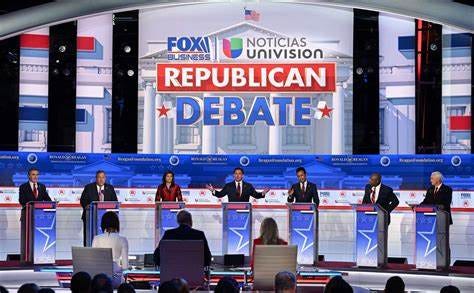I had planned to share some thoughts about the second Republican presidential candidate debate from Wednesday night. That was the plan. I recorded the debate so I could re-watch any exchanges a second time. I had my notebook next to me to jot down key parts so that I wouldn’t forget anything important. And that’s what I did for the first 20 minutes or so as the seven candidates shared the stage at the Ronald Reagan Presidential Library & Museum in Simi Valley, California.
And then I stopped. What was the point, really? This wasn’t really a debate. Or at least it wasn’t a meaningful debate. If you actually care about issues…if you care about whether candidates have unique ideas that can improve a problem or better someone’s life…if you care about how candidates compare to the other candidate who skipped the debate (Donald Trump)…then what good was this two-hour production? Not much.
Longtime Iowa television news director Dave Busiek made valid points about why it’s time to end debates. I hope he’s wrong. But I fear that he could be right.
Read the other Dave’s take on debates here.
And if you watched Wednesday’s debate, you might be inclined to agree with him. For much of the debate, it was a sh*t show. Candidates interrupting each other…candidates failing to answer the questions…candidates talking over the moderators…candidates making us wonder if they are even trying to beat Trump for the nomination. It was chaos. And largely worthless.
The moderators rarely tried to get the candidates to directly contrast themselves with Trump. And wouldn’t that have been a worthy service to potential voters?
They didn’t ask the candidates if they agreed with Trump’s allegation that chairman of the Joint Chiefs of Staff Mark Milley may have committed treason by reportedly agreeing to give China a heads up if Trump planned to attack that country during the final weeks of his presidency. A reminder: the punishment for treason can be death. Executing a military leader that Trump once entrusted for the job seems like a topic that merits discussion, no?
Also, what happened to “repeal and replace Obamacare?”
Does Trump have mental acuity, judgment and moral character to lead the country in 2025 and beyond?
Can drought-stricken California’s wildfires be prevented by just regularly watering the 33 million acres of forest as Trump contends?
Since the candidates were standing in the Reagan Library, can they describe whether Trump is upholding the values that Reagan espoused as the country’s leader? How do their compare their own leadership skills to Reagan?
Do they agree with Trump that Republicans should have shut down (partially) the federal government?
There’s so much, much more: By when could they balance the federal budget and how? What short-term, medium-term and long-term plans would they have for border security and for undocumented people already living in the U.S.? How would they offset the revenue loss from additional federal tax cuts? Do they believe the COVID-vaccines are killing people right and left?
I could go on. But, again, this format wasn’t going to allow time for real discussions and potential solutions. However, even if the candidates were all well-intentioned in their commitments to answering questions and explaining their views (somehow within the one minute that the debate format allowed), they weren’t really going to have the chance to enlighten voters. Not with seven candidates all on stage at once.
So how about this idea instead?
Don’t let seven candidates on the stage at once (and, yes, Trump should have shown up to explain his views to voters, too. But why would he? Politically, why take the risk?)
Let’s add some drama and intrigue to the format. Three candidates at a time. No more than that. Put all seven names in a hat. Have someone in the audience draw the three names.
Those chosen candidates walk out to the podium. For the next fifteen minutes, moderators only ask questions to those three. Quick commercial break. All names go back into the hat (or whatever). Someone else picks out three names. Those three candidates then debate for fifteen. Repeat, repeat, repeat…until the two hours is up.
The various permutations of threesomes could be fascinating, right? It could add intrigue, excitement and unpredictability. And best of all…hopefully…it would limit some of the chaos with some many candidates trying to talk at the same time. And maybe, just maybe, we voters could learn more about what the candidates would do as president instead of which ones are better at interrupting or parroting their rehearsed attack lines.
Dave Busiek could be right that maybe debates have just outlived their usefulness. But I’m not ready to give up on them yet. Let’s just change the rules. Politicians seem to change the rules all the time. Now it’s our turn. After all, we are ones who have to decide whether to hire them for the job.
Thanks for reading.
I write Dave Price’s Perspective as part of the Iowa Writers Collaborative, a group of three dozen independent writers across the state. Please check out some of the other writers and subscribe if you can.






I suppose due to probability, one (or a few) candidate(s) could end up with a disproportionately large amount of time to speak during the evening using your draw names from a hat, then draw from all names the next time(s) process. And you would have to figure out how to make sure no ones’s name does not get drawn at all.
However, limiting the number speaking each time is a great idea.
Will that solve the issue of not having questions regarding current, recent and important issues, though?
At least this would reduce the need to shout-over so many others at once! And if a candidate had prepared specific snarky one-liners for other specific candidate(s), this would reduce the likelihood they could uses them at all (why attack a candidate who is not on the stage with you?)
Thanks for your perspective.